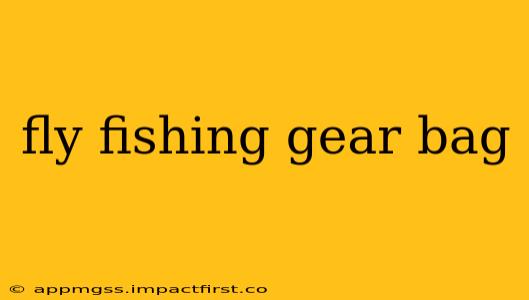Fly fishing demands careful organization and protection of your valuable equipment. A well-chosen fly fishing gear bag is essential, not just for keeping your gear safe, but also for making your time on the water more efficient and enjoyable. This comprehensive guide will help you navigate the world of fly fishing gear bags, ensuring you select the perfect pack for your needs and fishing style.
What are the Different Types of Fly Fishing Gear Bags?
Fly fishing bags come in a variety of shapes, sizes, and styles, each designed for specific needs and preferences. Understanding these differences is crucial for making an informed decision.
1. Backpack-Style Bags: These are excellent for carrying larger amounts of gear, especially when hiking to remote fishing spots. They offer excellent weight distribution and leave your hands free. Look for features like adjustable straps, padded compartments for rods, and multiple pockets for smaller items.
2. Chest Packs: Perfect for shorter trips or when you need quick access to frequently used items. Chest packs keep your essentials close and prevent them from bouncing around while you fish. They typically offer limited storage compared to backpacks.
3. Sling Bags: These bags are worn across the body, providing easy access to your gear and a comfortable carrying experience. They often strike a good balance between capacity and portability.
4. Roll-Top Dry Bags: Designed for ultimate water protection, these bags are perfect for keeping your gear dry even in the most challenging conditions. Their simple design is durable and ideal for protecting electronics and sensitive items. However, they usually lack the organized compartments of other bag styles.
5. Waterproof Cases & Boxes: These smaller, specialized containers keep fragile items, like flies and tippet, safe and organized. They are great additions to any larger bag.
What Features Should I Look for in a Fly Fishing Gear Bag?
Choosing the right fly fishing gear bag involves considering several key features. Don't rush the decision; take your time to evaluate your needs and preferences carefully.
1. Rod Storage: Proper rod protection is paramount. Look for bags with dedicated rod tubes or sleeves that prevent breakage during transport. Consider the length of your rods and choose a bag that accommodates them safely.
2. Waterproofing: Protect your gear from the elements with a waterproof or water-resistant bag. This is especially crucial for protecting electronics and sensitive items like flies.
3. Organization: Multiple compartments, pockets, and dividers keep your gear organized and easily accessible. Look for dedicated spaces for reels, fly boxes, leaders, and other essentials.
4. Durability: A high-quality bag should withstand the rigors of frequent use. Look for durable materials like nylon or ripstop fabric, and strong stitching.
5. Comfort: If choosing a backpack or sling bag, ensure comfortable straps and padding to prevent discomfort during long fishing trips.
How Much Should I Spend on a Fly Fishing Gear Bag?
The price range for fly fishing gear bags varies significantly, depending on features, quality, and brand. You can find basic bags for under $50, while high-end models can cost upwards of $200. It's crucial to balance your budget with your needs. A more expensive bag might offer superior durability, organization, and features, potentially saving you money in the long run by protecting your investment in other fly fishing equipment.
What are the Best Brands of Fly Fishing Gear Bags?
Many reputable brands manufacture high-quality fly fishing gear bags. Researching specific brands and reading reviews before purchasing can be beneficial. Some popular brands include Orvis, Simms, Patagonia, and Fishpond. Remember to choose a brand with a reputation for durability and customer service.
How Do I Maintain My Fly Fishing Gear Bag?
Regular maintenance will extend the lifespan of your fly fishing gear bag. After each trip, clean the bag and allow it to dry completely before storing. Address any minor repairs promptly to prevent further damage. Proper care will keep your gear safe and your bag in top condition for many fishing adventures.
What Accessories Should I Consider for My Fly Fishing Gear Bag?
Consider supplementing your bag with useful accessories:
- Waterproof fly boxes: protect your valuable flies from moisture.
- Nippers and other essential tools: keep your tools organized and easily accessible.
- Additional storage pouches: optimize space and organization.
By carefully considering these factors, you can find the perfect fly fishing gear bag to suit your individual needs and enhance your fishing experience. Remember, investing in a quality bag is an investment in protecting your equipment and ensuring many enjoyable days on the water.
